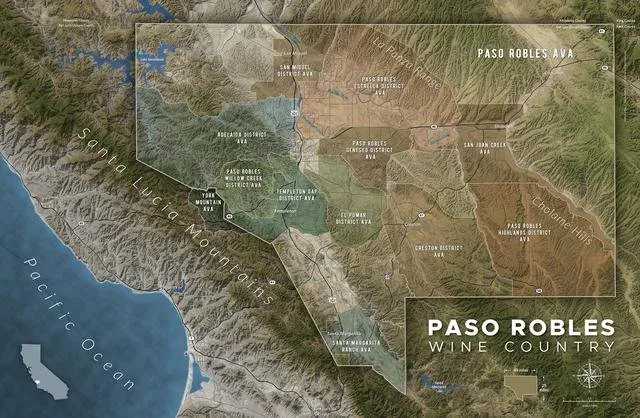


The Golden State of California has long been synonymous with wine production, with regions like Napa Valley and Sonoma County attracting attention from wine connoisseurs globally. Yet, there's another name that has been making waves in the wine scene: Paso Robles. This Central Coast gem, known for its unique terroir, diverse wines, and warm hospitality, is a must-visit for any wine lover.
Paso Robles, Spanish for "Pass of the Oaks," is located between San Francisco and Los Angeles. It is one of California's largest and most diverse wine regions, with over 200 wineries sprawled across 614,000 acres. The region is divided into 11 distinct viticultural areas, each with its microclimates, making it a hotbed for a wide range of wine grape varietals.
The rolling hills, warm days, cool nights, and the Pacific Ocean's influence converge to create a unique environment ideal for grape growing. These conditions, coupled with the inventive spirit of local winemakers, have led to Paso Robles gaining recognition as a premier wine-growing region. Grapes Flourish in Paso Robles.
Paso Robles' location and geography have blessed it with a Mediterranean climate characterized by long, hot, dry summers and brief, mild winters. The diurnal temperature swing—the change in temperature from the day's highest to the lowest—is one of the most significant in the world. This fluctuation allows grapes to ripen during the day and recover and retain their acidity during the cooler nights. Exploring the Vibrant Wine Culture.
The region's terroir—a term used to describe the natural environment in which a particular wine is produced, including factors such as soil, topography, and climate—is diverse and complex. The different microclimates within the region have led to an impressive array of grape varietals being cultivated, with over 40 different types grown.
The Paso Robles region is known for its rich, calcareous soils, a type of soil high in calcium carbonate and lime. This soil type is particularly conducive to wine grape growing as it retains water efficiently and offers excellent drainage, both essential for maintaining the vine's health.
Additionally, calcareous soils have inherent alkalinity, which can stress grapevines, leading to lower yields of higher quality, intensely flavored fruits. The resulting wines often have a bright acidity and a unique mineral characteristic, adding to their complexity and appeal.
Cabernet Sauvignon is Paso Robles's most widely planted grape, covering over 40% of the vineyard acreage. The varietal thrives in the region's warm climate and calcareous soils, producing full-bodied wines with robust tannins, deep, dark fruit flavors, and a hint of spice. The best examples showcase a beautiful balance between power and elegance, with a structure that allows for significant aging potential.
Petite Sirah, known for its inky color and bold flavors, is another grape varietal that shines in Paso Robles. The small, thick-skinned grapes produce dense, full-bodied wines loaded with rich, dark fruit flavors, pepper, and spice. These wines have a high tannin content, which can make them a bit austere in their youth. However, they can develop intriguing complexity and silky texture with time.
Paso Robles has gained a reputation for its Rhône-style blends, wines made from grape varietals traditionally grown in the Rhône Valley of France. Grenache, Syrah, and Mourvèdre (often referred to as GSM blends) are the dominant red varietals, while Roussanne, Marsanne, and Viognier lead the whites.
The Rhône blends from Paso Robles exhibit the warmth of the region, often offering ripe fruit flavors balanced by earthy and herbal notes. The reds can range from bright and juicy to rich and full-bodied, while the whites tend to have a lovely aromatic quality, with flavors of orchard fruits, citrus, and honey. Check Out: The Life Cycle of a Wine Barrel.
Though red wines are more prominent in Paso Robles, the region's white wines should not be overlooked. Varietals like Chardonnay, Viognier, and Roussanne thrive here, each expressing the terroir in unique ways.
Chardonnay from Paso Robles can range from lean and mineral-driven to rich and buttery, depending on the winemaking techniques employed. Viognier is often lush and full-bodied with its intoxicating floral aromas and flavors of stone fruit. Roussanne, traditionally used in Rhône blends, is sometimes bottled on its own, offering notes of honey, ripe pear, and a refreshing minerality.
In conclusion, Paso Robles is a wine region of a stunning diversity in terms of the varietals it grows and the styles of wines it produces. From the power and elegance of its Cabernet Sauvignon to the bold flavors of its Petite Sirah, from the nuanced complexity of its Rhône blends to the aromatic allure of its white wines, Paso Robles offers a wine for every palate. Its unique combination of climate, terroir, and calcareous soils, paired with the passionate dedication of its winemakers, makes it a treasure trove for any wine enthusiast.
~ Kay Syrah
Wine Country Guru Gal